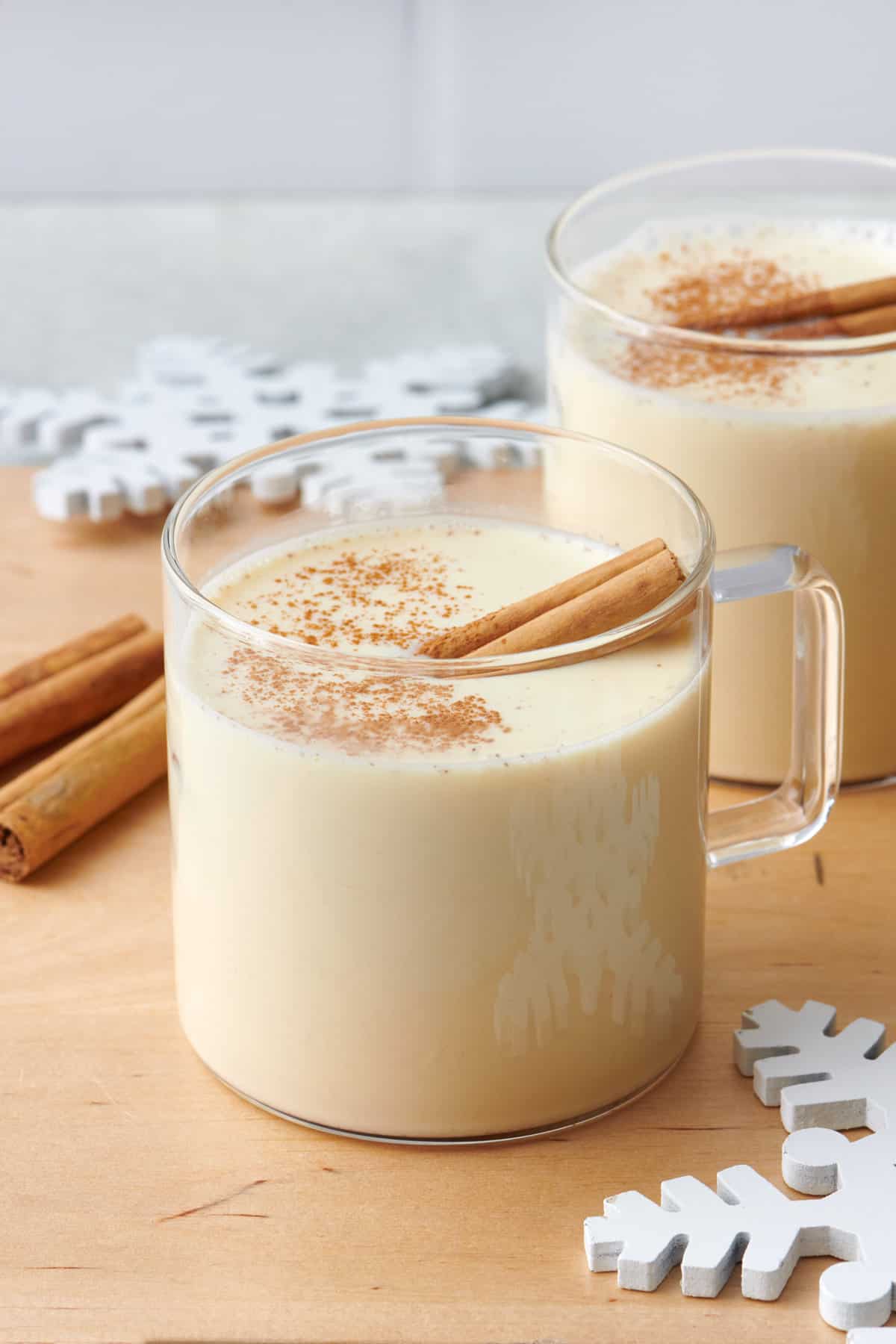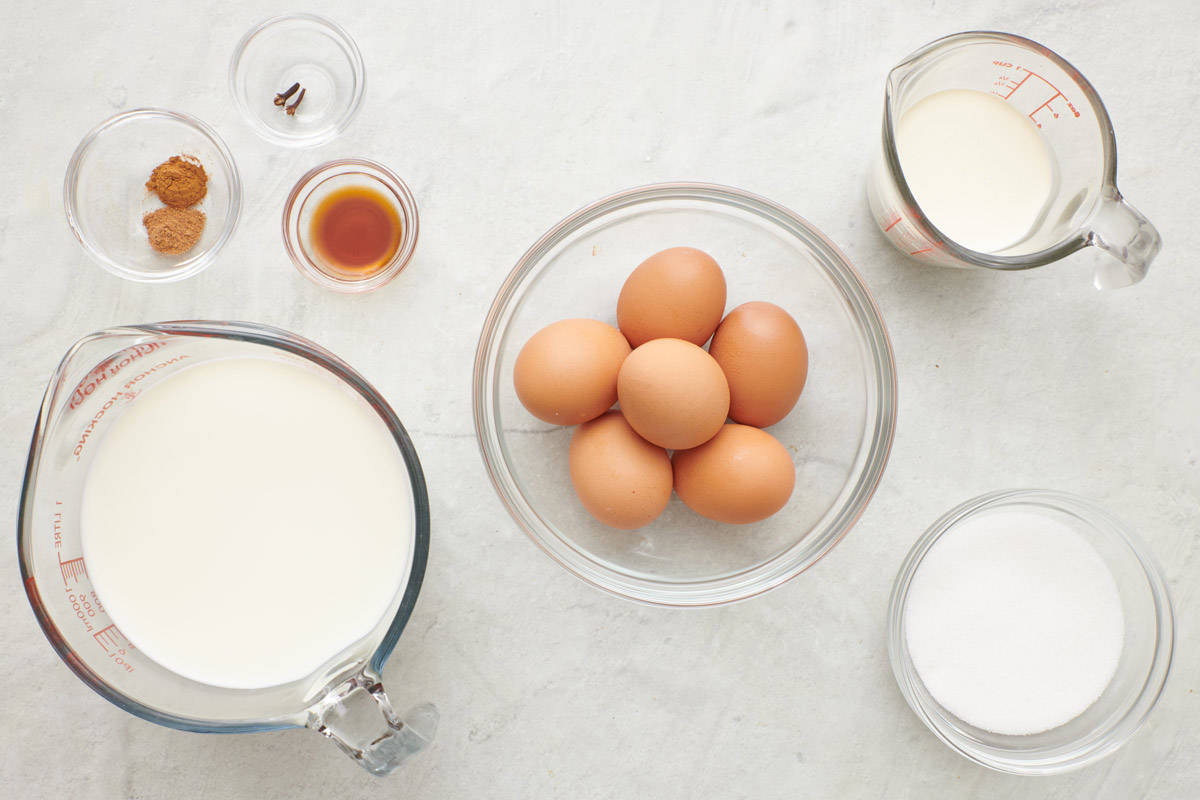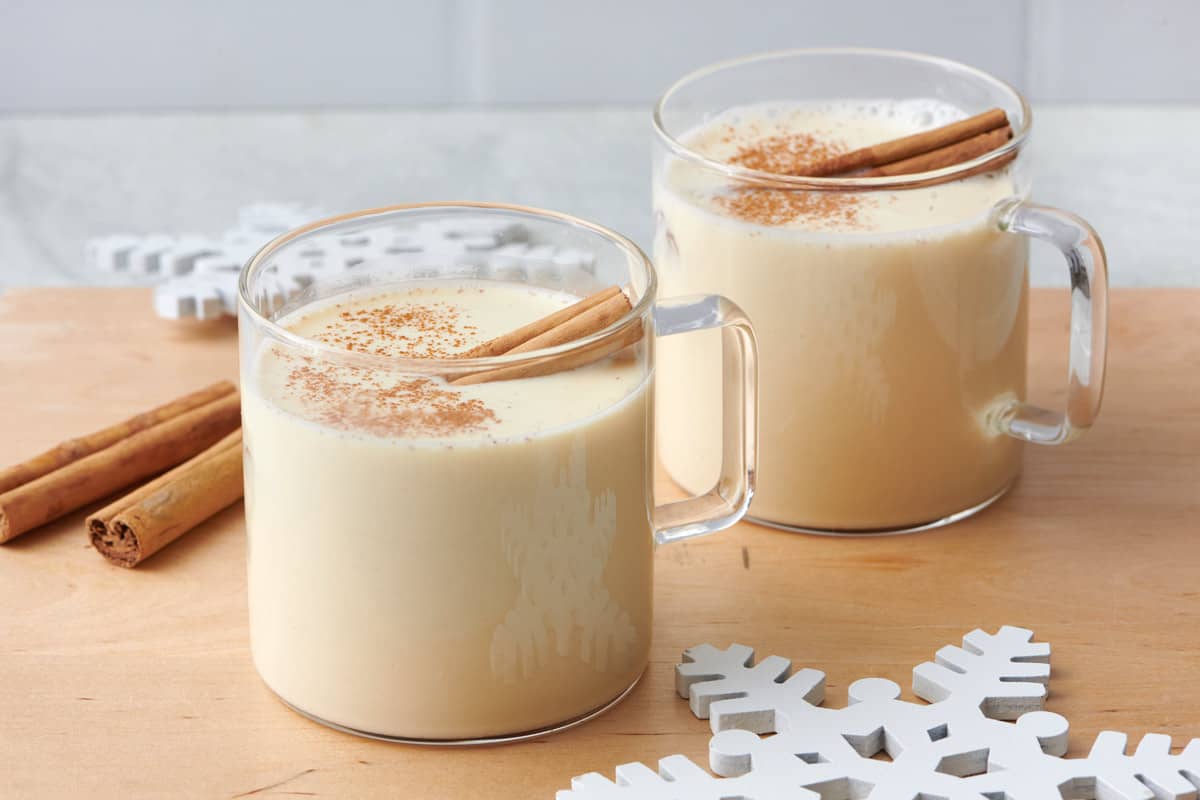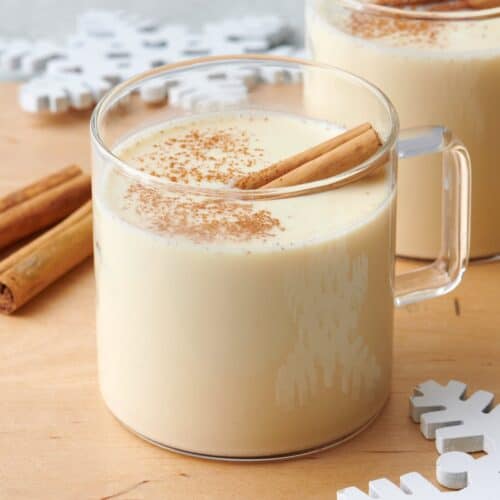How to Make Eggnog
Updated Dec 18, 2024
How to Make Eggnog - a classic holiday drink made with egg yolks, sugar, milk, and nutmeg. Chill, pour, sprinkle nutmeg, and enjoy!
This post may contain affiliate links. Please read our disclosure policy.
Learn how to make eggnog at home from scratch – yes, using real eggs! If the idea of making your own eggnog sounds daunting, don’t worry; it’s easier than you might think, and the result is absolutely worth it. This homemade eggnog recipe is all about bringing together simple, wholesome ingredients to create a rich, creamy drink that’s a staple during the holiday season.

Jump to Section
I’m personally not the biggest fan of eggnog because it’s not something that I grew up having. However, I still love to serve it to my guests during holiday parties because the aroma and taste is so warm and inviting during the season. And nothing beats thick, creamy eggnog, made at home with love. I may not have the same sentimental attachment to it, but I know that homemade eggnog brings joy to those who eagerly anticipate it during the holidays.
Why learn how to make eggnog
- Simple and approachable recipe. Eggnog can seem intimidating with tempering the egg yolks and simmering the milk mixture, but I lay everything out in this straightforward recipe. Plus, I share tips and tricks so you’re successful on the first try.
- Perfect flavor balance. The combination of seasonal spices like nutmeg, cinnamon, and cloves strikes a perfect balance of warm, festive flavors. It’s not overly sweet and has that velvety mouthfeel with every sip.
- Holiday drink that anyone can enjoy. This recipe skips the alcohol, making it a drink everyone, including kids or those avoiding alcohol, can enjoy during the holiday festivities. This non-alcoholic eggnog recipe stays true to the rich, creamy goodness of traditional eggnog without any spirits.
Ingredients to make eggnog

- Egg yolks: Adds richness and thickness to the eggnog, creating a custard-like texture. Be sure to use high-quality, fresh eggs. You can save the egg whites to use them to make candied walnuts or pecans.
- Milk and heavy cream: Forms the base of the eggnog. Avoid using skim or reduced-fat milk as that will dilute the eggnog. The additional heavy cream will help contribute to a rich, creamy eggnog.
- Granulated sugar: The main sweetener in the eggnog. Not only does the sugar enhance the overall flavor, but it also helps to thicken the eggnog slightly as it dissolves.
- Cinnamon and Nutmeg: These warm spices lend an aromatic and intense flavor that is characteristic of traditional eggnog.
- Vanilla extract: Adds a sweet and aromatic vanilla flavor that complements the warming spices.
- Whole cloves: Added to the milk mixture to infuse subtle spiced flavor into the eggnog. The cloves will be removed during straining to avoid an overpowering taste.
Popular substitutions & additions
- Milk: Feel free to use alternative milk options like almond milk, soy milk, or coconut milk for a dairy-free eggnog. Keep in mind that the flavor and texture may differ if using an alternative milk.
- Sweetener: Try using a different sweetener like honey, maple syrup, or agave nectar. You may need to adjust based on your desired level of sweetness, as some are sweeter than others.
- Try other spices: Add a small knob of fresh ginger to the milk mixture or a teaspoon of pumpkin pie spice to give it fall flavors.
- Have fun with toppings: A simple sprinkle of fresh ground cinnamon is enough to enjoy a mug of creamy eggnog. But you can also top it with a dollop of whipped cream and a drizzle of melted chocolate.
How to make eggnog
Learning how to make eggnog without alcohol is simpler than you think. Start by whisking the egg yolks with sugar and then tempering the mixture with warm milk. Then, gently cook to combine everything. Strain, chill, and it’s ready to be enjoyed – rich, creamy, and alcohol-free!
Make egg mixture
- In a large heat-safe bowl, add egg yolks, sugar, nutmeg, and cinnamon.
- Whisk by hand until the sugar has been incorporated and has mostly dissolved.

Make eggnog on the stove
- Add milk, heavy cream, vanilla, and cloves to a medium-sized, heavy-bottomed saucepan.
- Bring the milk mixture to a simmer over medium heat. When you see the bubbles form around the sides of the saucepan, remove from heat.
- Slowly pour about half a cup of the warm milk mixture into the egg yolk mixture, and whisk to temper the egg yolks.
- Pour everything into the same pot and cook for a few minutes on low heat.
- Strain the cooked mixture through a fine mesh strainer to remove any cooked bits and the whole cloves.
- Chill the eggnog well before serving.

Tips for making the best homemade eggnog
- Don’t worry about raw eggs. Cooking the egg yolks to 160˚F in step 4 will ensure that any harmful bacteria from the raw eggs have been destroyed.
- Avoid overheating the milk mixture. You want it to simmer gently with small bubbles forming on the edges of the milk. A full boil can lead to overheating and curdling.
- Don’t be intimidated by tempering the eggs. Just think of it as gently warming up the eggs so that they don’t immediately cook when added to the warm liquid.
- Notice that it will thicken as it sits. I like to keep the mixture a little lighter so you’ll notice it may not be as thick as packaged eggnog at first. But if you let it sit in the fridge, it will definitely thicken up.

How to store & reheat eggnog
Transfer eggnog to a clean, airtight container and store it in the refrigerator. Eggnog is a dairy product and must be chilled. Before serving, give it a good shake or stir well to help redistribute any settled ingredients.
Traditional eggnog is meant to be enjoyed chilled, but if you want to warm it up, you can do so in a small saucepan over medium-low heat until heated to your liking. Take care not to overheat it, though.
How long will eggnog last in the fridge?
Homemade eggnog will last in the fridge for about 2-3 days. This non-alcoholic eggnog recipe doesn’t have the preservatives as in storebought eggnog, so it’s best consumed within a few days.
Can I freeze homemade eggnog?
It’s generally not recommended to freeze eggnog because as with most dairy products, separation will occur. However, if you have lots of leftover eggnog, you can freeze it to be added to smoothies later. To freeze, transfer the eggnog to a freezer-safe container, leaving plenty of headspace for expansion. Freeze for up to 6 months. When ready to enjoy, thaw overnight in the fridge and stir or shake well before serving.
Frequently asked questions
Tempering the egg yolks involves gradually adding a small amount of the hot milk liquid to bring them to a warmer temperature without cooking them. This ensures a smooth and creamy eggnog. If you were to add the eggs to the hot milk mixture without tempering, you would likely cook them, creating scrambled egg yolks in your eggnog.
Yes, you can make a non-dairy version of eggnog by using dairy alternatives like almond milk, coconut milk, soy milk, or oat milk. You may need to adjust the amount of sugar to suit your taste, as some of the non-dairy milks may already have a hint of sweetness.
Even though homemade eggnog doesn’t have a long shelf life, there are lots of ways to enjoy eggnog besides just drinking it. Use it various recipes such as pancakes, French toast, or even as a base for creamy smoothies like in this breakfast coffee smoothie.

Knowing how to make eggnog without alcohol allows all your guests to savor this holiday drink, whether they’re underage or simply because of personal reasons. It’s a simple yet thoughtful addition to your holiday gatherings that brings people together over a cozy mug of homemade eggnog.
More holiday beverage recipes:
- Homemade Apple Cider
- Hot Cocoa Bombs
- Vegan Hot Chocolate
- Homemade Pumpkin Spice Latte
- Hot Matcha Latte
- Golden Milk Turmeric Latte
- Pumpkin Cream Cold Brew
- Ginger Turmeric Tea
If you try this feel good How to Make Eggnog recipe or any other recipe on Feel Good Foodie, then don’t forget to rate the recipe and leave a comment below! It helps others who are thinking of making the recipe. We would love to hear about your experience making it. And if you snapped some shots, share it on Instagram so we can repost on Stories!

How to Make Eggnog
Video
Ingredients
- 6 egg yolks
- ½ cup granulated sugar
- ¼ teaspoon nutmeg
- ¼ teaspoon cinnamon
- 3 ½ cups whole milk
- ½ cup heavy cream
- 1 teaspoon vanilla extract
- 2 whole cloves
Instructions
- In a large heat safe bowl combine egg yolks, sugar, nutmeg and cinnamon. Whisk the egg yolks by hand until the sugar has been incorporated and has mostly dissolved, about 2 minutes.
- Place the milk, heavy cream, vanilla and cloves in a medium, heavy-bottomed saucepan. Bring to a simmer over medium heat. When you see bubbles forming around the sides of the pan, remove from the heat. Do not let this mixture come to a full boil. Using about ½ cup of the warm milk mixture, whisk it into the egg yolk mixture to temper the egg yolks, then pour everything into the same pot and cook to160˚F on an instant read or candy thermometer.
- Strain the cooked mixture through a fine mesh strainer to remove any cooked bits and the whole cloves, then chill for at least 1 hour before serving.
Equipment
Notes
Nutrition
Nutrition information provided is an estimate. It will vary based on cooking method and specific ingredients used.






Comments
Have you ever tried spiking your homemade eggnog with a unique liquor or flavor combination to give it an extra kick? Share your favorite unconventional eggnog recipe twist with us!
Hi there! I don’t drink alcohol, so I don’t have any recommendations here. So sorry!
I like it
Thank you so much, Michael!